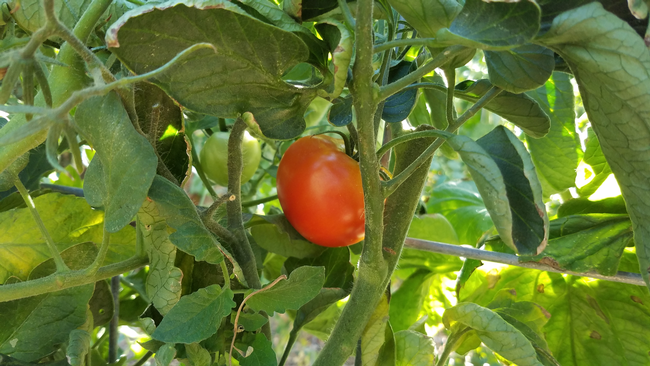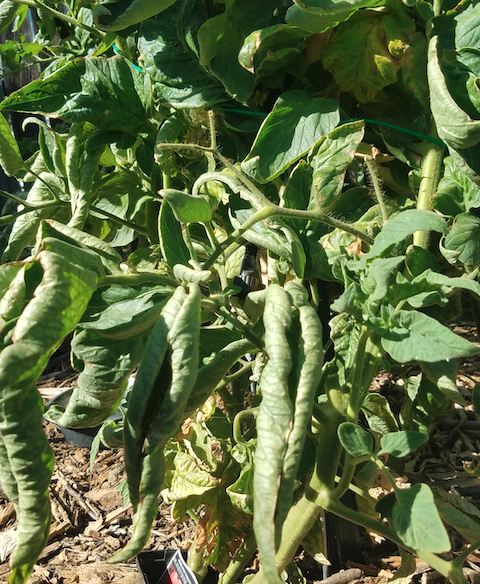
Tomatoes are ripening all over California right now keeping many gardeners and tomato lovers busy picking, canning, and eating. But what may not make gardeners happy are seeing curled leaves and not knowing why. There are many reasons why your tomato leaves may be curling or rolling. Being able to narrow down possible causes takes a bit of detective work, but using this article and UC IPM's Plant Problem Diagnostic Tool can make it achievable!
Tomato leaf curl can be the result of:
Environmental stressors
Leaf curl on tomato is often caused by environmental stress, not necessarily pathogens or insects. Too much or too little water or nutrients, can make leaves curl. A wet spring, followed by warm weather can cause physiological leaf roll. Leaves may roll downward and become firm and leathery. Usually, the lowest leaves are affected most and the plant appears healthy otherwise. When conditions become more favorable, like more water if the plant hasn't been getting enough or consistent watering, environmental stressors will often resolve themselves and the plant will recover.
Plant pathogens

Several viral infections can cause tomato leaves to curl. Curly top virus causes leaves to cup downward, become thick and brittle, and stunts plant growth. Tobacco mosaic virus results in mottled leaves that appear stringy and distorted. Tomato spotted wilt virus causes downward-cupped leaves and necrotic spots. It is important to note that viruses can be transmitted to tomatoes, and other garden plants, by sap-sucking insects. Therefore, their control is important in preventing these viruses. There is no treatment for virus-infected plants, so it is best to remove and dispose of them.
Insects
Aphids, whiteflies, thrips and other sap-sucking insects can cause leaves to curl by sucking plant juices out of the leaves. Check the undersides of leaves to look for these insects. Once you have identified the culprit, see the UC IPM fact sheets (Pest Notes) on various methods for managing them.
You may see some ‘good bugs' around the garden too. Many natural enemies will feed on these pest insects, so keep an eye out for lady beetles, lacewings, and minute pirate bugs. Also look for signs of parasitization (like aphid mummies) from parasitoid wasps!
Herbicide injury
If you recently applied an herbicide near your tomato plants, their leaves could be curling from herbicide drift or contamination. When tomato plants come in contact with herbicides, like 2,4-D, their leaves may curl or cup and become distorted.
How can you prevent tomato leaf curl?
- Choose pathogen resistant tomato varieties.
- Harden off plants or wait for the weather to warm up before planting outside.
- Ensure tomatoes receive consistent and adequate water.
- Use the correct amount of fertilizer.
Visit the UC IPM website for more information about tomato pests, issues, and cultural controls. If you have additional questions, please contact your local UC Master Gardeners for more information.